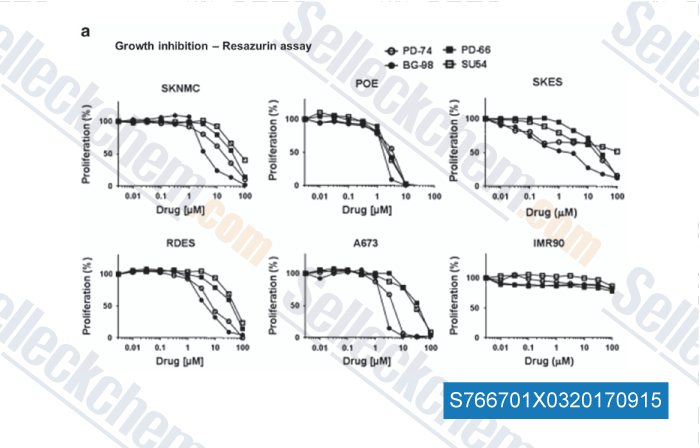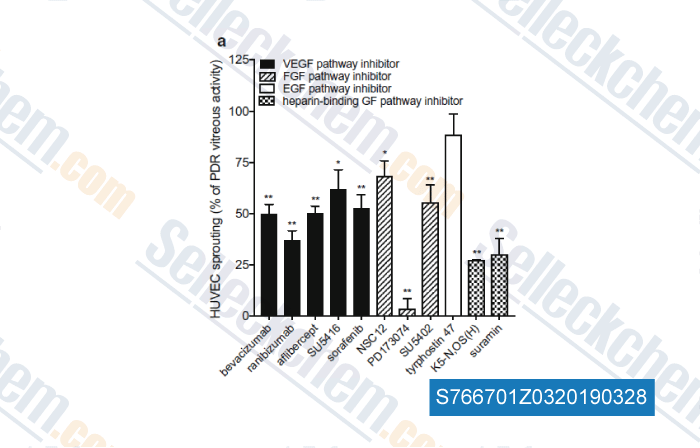|
Toll Free: (877) 796-6397 -- USA and Canada only -- |
Fax: +1-832-582-8590 Orders: +1-832-582-8158 |
Tech Support: +1-832-582-8158 Ext:3 Please provide your Order Number in the email. |
Technical Data
| Formula | C17H16N2O3 |
|||
| Molecular Weight | 296.32 | CAS No. | 215543-92-3 | |
| Solubility (25°C)* | In vitro | DMSO | 59 mg/mL (199.1 mM) | |
| Water | Insoluble | |||
| Ethanol | Insoluble | |||
|
* <1 mg/ml means slightly soluble or insoluble. * Please note that Selleck tests the solubility of all compounds in-house, and the actual solubility may differ slightly from published values. This is normal and is due to slight batch-to-batch variations. * Room temperature shipping (Stability testing shows this product can be shipped without any cooling measures.) |
||||
Preparing Stock Solutions
Biological Activity
| Description | SU5402 is a potent multi-targeted receptor tyrosine kinase inhibitor with IC50 of 20 nM, 30 nM, and 510 nM for VEGFR2, FGFR1, and PDGF-Rβ, respectively. | ||||||
|---|---|---|---|---|---|---|---|
| Targets |
|
||||||
| In vitro | SU5402 inhibits VEGF-, FGF-, PDGF- dependent cell proliferation with IC50 of 0.05 μM, 2.80μM, 28.4 μM, respectively. [1] In HUVECs, SU5416 selectively inhibits VEGF-driven mitogenesis in a dose-dependent manner with IC50 of 0.04 μM. [2] In nasopharyngeal epithelial cells, SU5402 attenuates LMP1-mediated aerobic glycolysis, cellular transformation, cell migration, and invasion. [3] In mouse C3H10T1/2 cells, SU 5402 diminishes the effect of FGF23 on cell differentiation. [4] | ||||||
| In vivo | In mice, SU5416 (25 mg/kg, i.p.) inhibits subcutaneous growth of a panel of tumor cell lines by inhibiting the angiogenic process associated with tumor growth. [2] |
Protocol (from reference)
| Kinase Assay:[1] |
|
|---|---|
| Cell Assay:[2] |
|
| Animal Study:[2] |
|
References
Customer Product Validation

-
Data from [Data independently produced by , , Oncogene, 2017, 36(6):766-776]

-
Data from [Data independently produced by , , Angiogenesis, 2017, 20(4):629-640]
Selleck's SU5402 has been cited by 18 publications
| Reconstructing the regulatory programs underlying the phenotypic plasticity of neural cancers [ Nat Commun, 2024, 15(1):9699] | PubMed: 39516198 |
| Host-to-graft propagation of inoculated α-synuclein into transplanted human induced pluripotent stem cell-derived midbrain dopaminergic neurons [ Regen Ther, 2024, 25:229-237] | PubMed: 38283940 |
| Oxidative stress induces lysosomal membrane permeabilization and ceramide accumulation in retinal pigment epithelial cells [ Dis Model Mech, 2023, 16(7)dmm050066] | PubMed: 37401371 |
| Generating Neural Retina from Human Pluripotent Stem Cells [ J Vis Exp, 2023, (202).] | PubMed: 38189566 |
| Microglia-derived PDGFB promotes neuronal potassium currents to suppress basal sympathetic tonicity and limit hypertension [ Immunity, 2022, S1074-7613(22)00291-6] | PubMed: 35863346 |
| Generation of GLA-knockout human embryonic stem cell lines to model peripheral neuropathy in Fabry disease [ Mol Genet Metab Rep, 2022, 33:100914] | PubMed: 36092250 |
| Control of osteoblast regeneration by a train of Erk activity waves [ Nature, 2021, 10.1038/s41586-020-03085-8] | PubMed: 33408418 |
| Cohesin-protein Shugoshin-1 controls cardiac automaticity via HCN4 pacemaker channel [ Nat Commun, 2021, 12(1):2551] | PubMed: 33953173 |
| NOCICEPTRA: Gene and microRNA Signatures and Their Trajectories Characterizing Human iPSC-Derived Nociceptor Maturation [ Adv Sci (Weinh), 2021, 8(21):e2102354] | PubMed: 34486248 |
| The cytokine FAM3B/PANDER is an FGFR ligand that promotes posterior development in Xenopus [ Proc Natl Acad Sci U S A, 2021, 118(20)e2100342118] | PubMed: 33975953 |
RETURN POLICY
Selleck Chemical’s Unconditional Return Policy ensures a smooth online shopping experience for our customers. If you are in any way unsatisfied with your purchase, you may return any item(s) within 7 days of receiving it. In the event of product quality issues, either protocol related or product related problems, you may return any item(s) within 365 days from the original purchase date. Please follow the instructions below when returning products.
SHIPPING AND STORAGE
Selleck products are transported at room temperature. If you receive the product at room temperature, please rest assured, the Selleck Quality Inspection Department has conducted experiments to verify that the normal temperature placement of one month will not affect the biological activity of powder products. After collecting, please store the product according to the requirements described in the datasheet. Most Selleck products are stable under the recommended conditions.
NOT FOR HUMAN, VETERINARY DIAGNOSTIC OR THERAPEUTIC USE.
